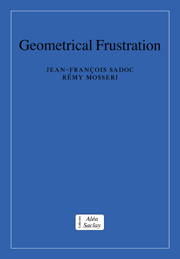Book contents
- Frontmatter
- Contents
- Preface
- 1 Introduction to geometrical frustration
- 2 Ideal models
- 3 Finite structures
- 4 Decurving and disclinations
- 5 Hierarchical polytopes
- 6 Some physical properties
- 7 Periodic structures with large cells
- 8 Quasiperiodic order and frustration
- A1 Spaces with constant curvature
- A2 Quaternions and related groups
- A3 Hopf fibration
- A4 Polytopes and honeycombs
- A5 Polytope {3, 3, 5}
- A6 Frank and Kasper coordination polyhedra
- A7 Quasiperiodic tilings: cut and projection
- A8 Differential geometry and parallel transport
- A9 Icosahedral quasicrystals and the E8 lattice
- Bibliography
- Index
3 - Finite structures
Published online by Cambridge University Press: 06 January 2010
- Frontmatter
- Contents
- Preface
- 1 Introduction to geometrical frustration
- 2 Ideal models
- 3 Finite structures
- 4 Decurving and disclinations
- 5 Hierarchical polytopes
- 6 Some physical properties
- 7 Periodic structures with large cells
- 8 Quasiperiodic order and frustration
- A1 Spaces with constant curvature
- A2 Quaternions and related groups
- A3 Hopf fibration
- A4 Polytopes and honeycombs
- A5 Polytope {3, 3, 5}
- A6 Frank and Kasper coordination polyhedra
- A7 Quasiperiodic tilings: cut and projection
- A8 Differential geometry and parallel transport
- A9 Icosahedral quasicrystals and the E8 lattice
- Bibliography
- Index
Summary
Finite clusters
There is much experimental evidence that atomic finite clusters do not present necessarily the same geometrical order as in their crystalline counterparts. For instance, rare gas clusters often display icosahedral symmetry, their detailed structure depending on atomic species and size (Farge et al. 1975). It is now possible to grow and study metallic or covalent clusters, ranging from a few atoms up to several hundred atoms (Joyes 1990, Paillard et al. 1994). They are interesting not only for themselves (in the context of catalysis for example) but also to better understand cohesive properties of solids, or in the context of amorphous structures, since they can possibly model the local order of the non-crystalline solid during the growth process. One should not forget however that surface effects play a dominant role in cluster stability while their role in glasses should only be invoked for a dynamical process.
Several types of cluster have been proposed in the past. Some of them have a close relationship with mapped polytopes. The main results have been summarized elsewhere (Mosseri 1988a, Mosseri and Sadoc 1989), which we now describe.
Cluster indexation
We want to index finite clusters which can be derived from a given polytope P whose sites are decorated by atoms. A finite portion of P is mapped onto a tangent hyperplane R3. We need to specify the tangent point T and the polar angle ω which limits the region to be mapped, and as a consequence the size of the mapped cluster.
- Type
- Chapter
- Information
- Geometrical Frustration , pp. 45 - 56Publisher: Cambridge University PressPrint publication year: 1999



